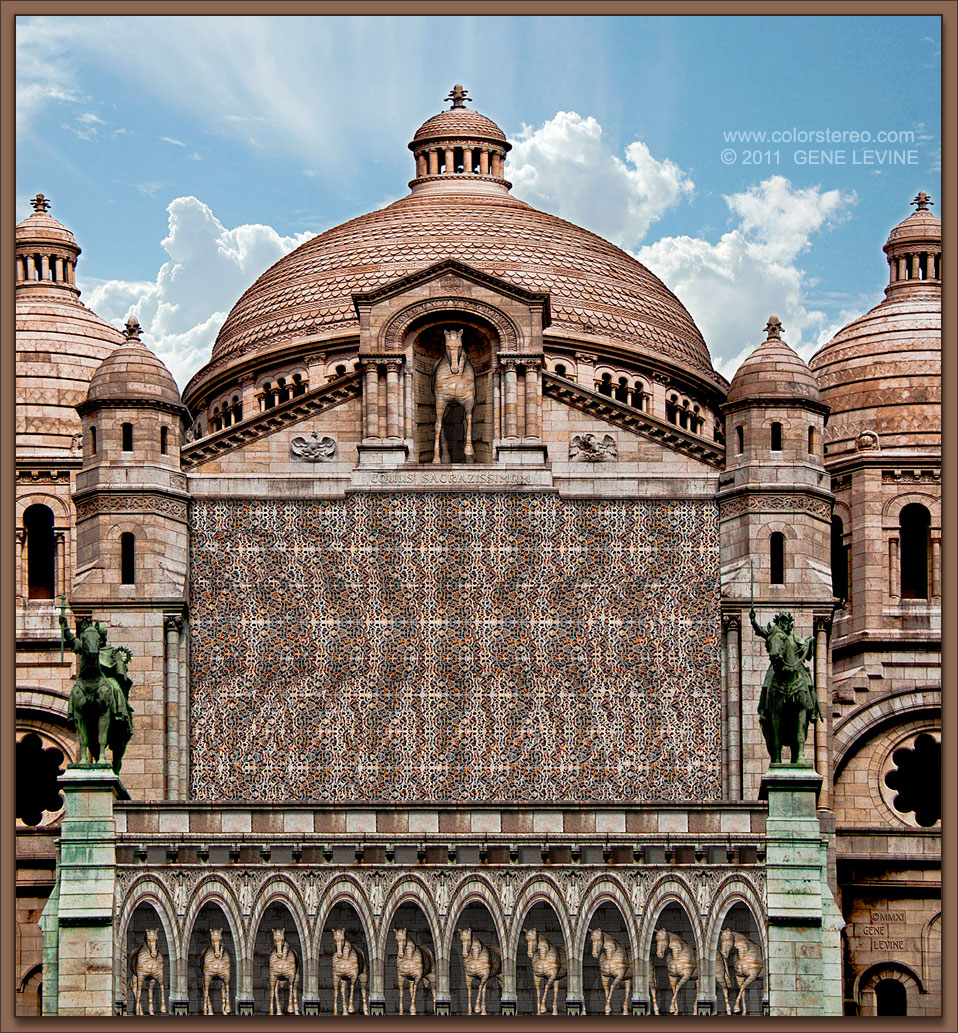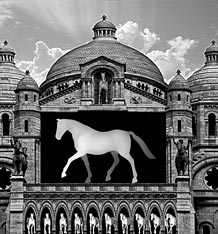| Stereogram Galleries | Custom Stereograms | Anaglyph Galleries | Publications |
A Subjective Discourse on the Evolution of 3D Stereograms It has been argued early cave dwelling artists were aware of the 3D properties of divergent vision. However, the technical inability to repeat a pattern with any precision makes this doubtful. The earliest examples of stereo image repetition was likely the Great Ziggurat of Ur erected in the 21'rst century BCE by the Sumerians. Though the original decor has long worn away, the multi tiered structural patterns leave little doubt that not all artisans or acolytes could be unaware of its magical 3D properties. Ancient stereogram imagery was regarded
to be actual magic and carried the value of rare spice or precious
metals. A golden arc, its outside engraved with repeating cuneiform,
and inside containing the very first beginnings of a nascent 3D algorithm
was sent by Zoroastrian priests as a blessing and gesture of good will
to the Egyptian Court around the 12th dynasty. No record of stereo vision is recorded in Western civilization until Alexander the Great invaded Egypt and stumbled onto mysterious divergent vision hieroglyphs spread across the lost tomb walls of Pharaoh Stereopsisis. The hieroglyphs were closely studied by Alexander's mathematicians: Demetrius, Diametrious, and Deximeter. They further refined the original algorithm and invented a mythological explanation for what was referred to as the vision of the Gods. Nine centuries later, Luthgarde, a member of the Optomecian Order of monks, rediscovered manuscripts of the greek mathematicians and referred to them in his journal as the Three D's. A few centuries later, a young Galileo, inspired by Luthgarde's journal, applied its mystic meanderings to a more practical theory and what can be considered the first true stereogram algorithm. Though it is generally regarded the Church had Galileo arrested for postulating it was Earth that orbited around the sun, in reality it was the parallel viewing of crude stereogram images that got him imprisoned for using what the Pope called "demon vision." Papal condemnation and the two dimensional emphasis of Renaissance paintings kept stereogram art latent until the advent of Modern Art between the two World Wars. Stereograms were just beginning to gain public attention when the Second World War broke out. After the Nazis occupied Paris, they immediately declared stereograms a degenerative Bolshevik art form and destroyed all algorithms within the Sorbonne's Stereogram Department. They ultimately confiscated all European stereogram art and stacking it outside the Sacre Sirds Cathedral, set it on fire in what became infamously called Night of the Interesting Fire. Parisians, staring aghast into the flames swore they saw the Four Horsemen of the Apocalypse materialize as a 3D hidden-image. An Italian janitor working at the Sorbonne managed to smuggle out the one remaining algorithm which had escaped notice disguised as a tapestry of pure random dot pattern. It was handed over to the victorious Allies as soon as hostilities ended and was shipped to America where it lay warehoused for 50 years until recognized by a computer genius entrepreneur. Inside a decade, personal computers and modern media made stereograms the rage of the 1990's. After 4,000 years, they were again called magic. Gene Levine has become the most advanced practitioner in this art and taken stereograms from an ancient curiosity into the new-age. The images contained on the Color Stereo website are just the latest saga in this ancient magic. |
Sacre SIRDS Cathedral
Copyright MMXI Gene Levine, all rights reserved

